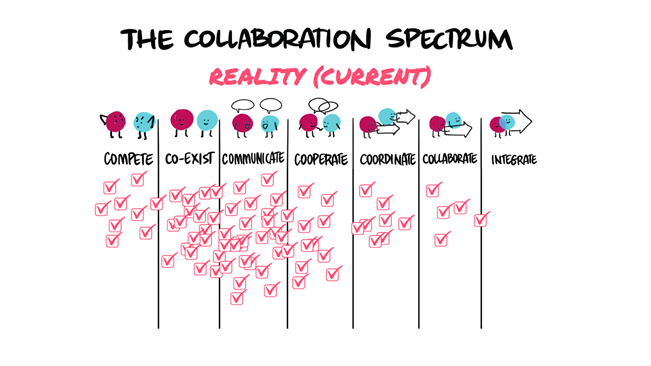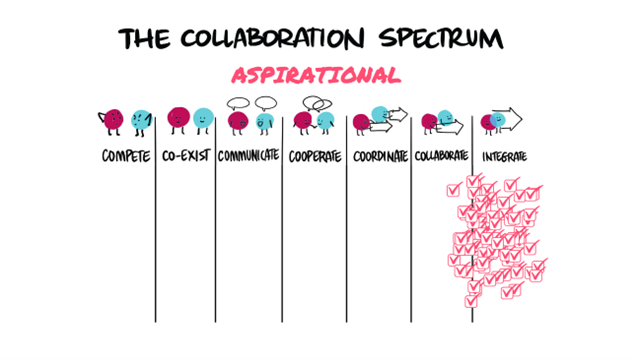We are discovering a shared truth: collaboration is necessary to improve population health outcomes, yet often difficult to reach. The personal desire for working together is strong and absolutely imperative. This is WHY we need to collaborate. What is missing are the enabling conditions that make collaboration possible and sustainable. When we focus on the HOW, we realize our potential for impact

Collaboration is often named as a priority but lived very differently in practice. The question is not whether leaders want to collaborate—it is whether the conditions exist to make it possible.

We use the Collaboration Spectrum, an evidence-based tool developped by Liz Weaver and the Tamarack Institute, to help people see where they are and what it takes to mature relationships across the system.
It makes clear that:
● Collaboration is not binary. It exists on a spectrum, from simple information-sharing to co-creation.
● Many efforts stall in the early stages, where communication exists but integration does not.
● Moving toward the far end of the spectrum requires intention, trust, and aligned purpose.
This is where aspiration meets reality. Leaders, teams, and communities consistently tell us that while they want to collaborate, their current practices fall short of what is needed for integration.
When asked to rate their current level of collaboration compared to their desired level—personally, within teams, across organizations, and with partners—the gap is clear.
● Over half report that their current practice falls far below their desired level.
● The aspiration to collaborate and integrate across organizations and sectors is strong, and widely shared.
● The gap persists regardless of sector or role.
This is not resistance to collaboration. It is a signal that structures and practices have not yet caught up to intent.
What we know and what we do are often different. Collaboration is talked about, even celebrated, but too often it happens only in pockets—held together by heroic efforts rather than sustainable design.
The Collaboration Spectrum creates a shared map of what is possible beyond those isolated examples. It shows a pathway for alignment across organizations, sectors, and communities. From micro teams, to meso partnerships, to macrosystems.


Collaboration is not a slogan. It is a skillset. And when practiced with intention, it becomes strategy: shaping how priorities are advanced, how intent is set, and how systems align to deliver on what matters.
This Insight to Action series is an invitation to learn together about how conditions for collaboration are built, how barriers can be named and addressed, and how commitments turn intent into action. It will also share insights from our work—insights learned and practiced together.
1. From Insight to Action: Connection Is the Correction — Building the Conditions for Integrated Care
2. The Nervous System of Change — how neuroscience shows us that trust is embodied, not abstract. As Stephen M.R.Covey reminds us, “Change happens at the speed of trust.” And in our work, we see the next layer: trust happens at the speed of the nervous system — across individuals, teams, organizations, and sectors.
3. Elephants that need to be named and addressed to move forward — how unspoken barriers keep systems stuck. Naming them is the first step, but the real work is in identifying which are within our control to change, and then acting on them.
4. Advancing on the Collaboration Spectrum — what our data tells us about the gap between the collaboration leaders—whether as a person with lived experience, a clinician, a community worker or those in formal leadership roles across policy, research, organizational and sector leadership—want and the collaboration they experience. It also highlights where individuals see themselves in their own growth, where their teams and organizations are positioned, and where they aspire to be.
5. Individual and Collective Commitments — how personal and collective commitments translate insight into measurable action.
To learn more about our collective pursuit and see the upcoming blogs, explore 4CImpact.org or to get in touch with Jodeme (jodeme@4cimpact.org) or Meghan (info@4CImpact.org).
This series was made possible by the 4C Impact team: Jodeme Goldhar, Deb Gollob, Justin Levinsky and Meghan Perrin.